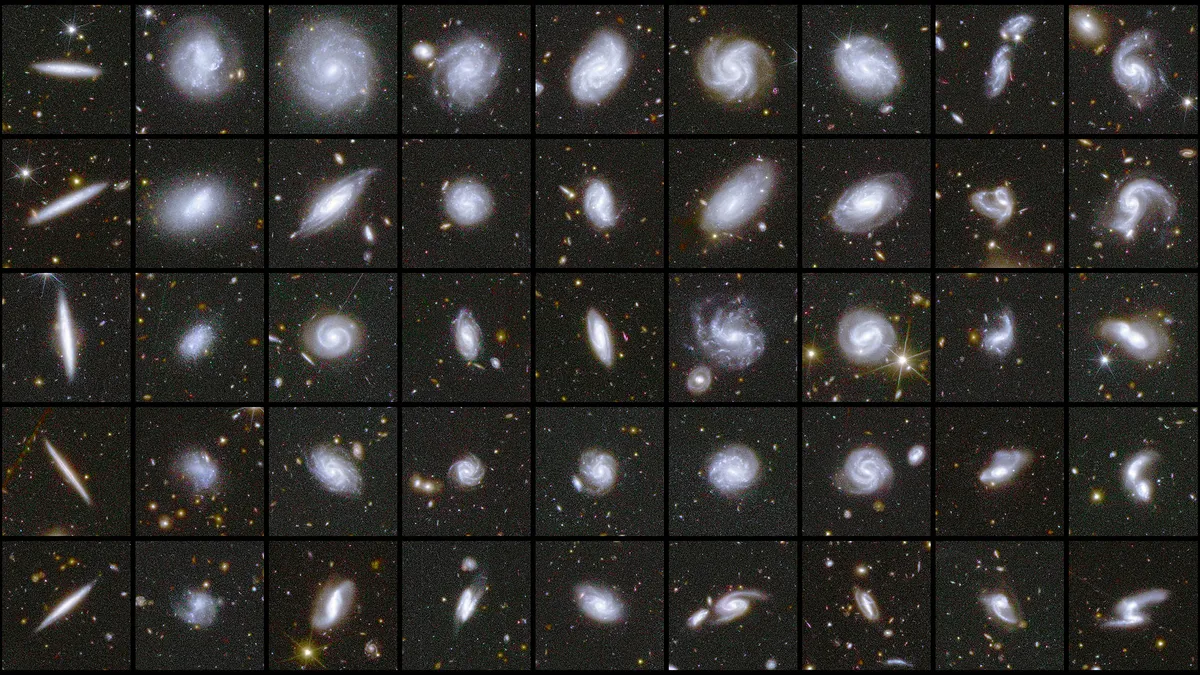
The European Space Agency (ESA) has recently released the first survey data from its groundbreaking Euclid mission. This initial data set showcases a stunning array of images that feature galaxies, clusters, and expansive cosmic fields, providing a preview of what is set to become one of the largest cosmic maps ever created. The release includes three deep field mosaics that highlight hundreds of thousands of galaxies, revealing their shapes, brightness, and distributions, which together paint a rich visual of the cosmic web.
In a remarkable achievement, the Euclid mission has mapped 63 square degrees of galaxy-filled sky in just one week. To put this into perspective, this area is equivalent to 300 full Moons. The mission has successfully captured over 26 million galaxies, including quasars located up to 10.5 billion light-years away. The ambitious plan for Euclid is to scan each of the three deep regions 30 to 52 times before 2030. Ultimately, the final sky map will encompass one-third of the sky, totaling around 14,000 square degrees. These repeated observations are designed to construct an incredibly detailed 3D cosmic atlas, helping researchers to explore the formation of galaxies and the influence of dark matter on their journeys.
“We are unlocking a treasure trove of information for scientists to dive into,” stated Professor Carole Mundell, the director of science at the European Space Agency.
Each new observation from Euclid enhances our understanding of the universe's large-scale structure. Filaments of both normal and dark matter stretch across the cosmos, resembling a vast web where galaxies have formed and evolved. The visible and near-infrared instruments aboard the Euclid spacecraft provide precise measurements of the shapes and distances of these galaxies. “Just think of the discoveries that await us,” emphasized Valeria Pettorino, an astrophysicist involved in the Euclid Project. ESA scientists are optimistic that these images will refine our understanding of dark matter and dark energy, two components that together constitute approximately 95% of the universe.
The extensive dataset generated by Euclid necessitates innovative strategies for analysis. Each day, the mission transmits an impressive 100 GB of data back to Earth. To manage this influx of information, scientists are employing AI models and enlisting the help of citizen scientists. A significant outcome of this effort is a new catalogue of over 380,000 galaxies, classified by their shape and features. “AI is a fundamental and necessary part of our process,” noted Mike Walmsley, a scientist from the Euclid Consortium at the University of Toronto, Canada, who has dedicated the past decade to developing astronomical deep learning algorithms.
The Zoobot algorithm, which has been trained by nearly 10,000 volunteers, is now capable of classifying galaxies based on traits such as spiral arms and mergers. This initial catalogue represents only 0.4% of what Euclid is expected to deliver throughout its mission.
As light travels from distant galaxies, it doesn't always follow a straight path. When it passes through matter—such as a galaxy or a cluster of galaxies—the light can bend due to gravity, a phenomenon known as gravitational lensing. This natural effect is instrumental in helping scientists detect dark matter, which is otherwise invisible. Through the combination of artificial intelligence and the efforts of human volunteers, Euclid has identified 500 potential examples of strong gravitational lenses, many of which had never been documented before. By the conclusion of the mission, it is anticipated that Euclid will discover approximately 100,000 strong lenses, a hundred times more than currently known. Each of these findings provides researchers with a powerful tool for studying the distribution of dark matter across the universe and how it shapes galaxies.
“We are combining the strengths of Euclid, AI, citizen science, and experts into a single discovery engine,” said Pierre Ferruit, ESA’s Euclid mission manager.
As of March 2025, Euclid had already scanned 2,000 square degrees of the sky, filled with galaxies—about 14% of its total planned survey. This is merely the beginning of the mission's work. The first complete set of cosmology data is expected to be shared in October 2026, which will include numerous repeated observations of three designated deep fields. These repeated scans will offer scientists a clearer, more detailed view of those remote aspects of the universe.
Launched in July 2023, the Euclid mission commenced its regular scientific operations in February 2024. ESA developed the spacecraft with support from NASA and collaborations with companies like Thales Alenia Space and Airbus. The mission is backed by the Euclid Consortium, a global collaboration of over 2,000 scientists from 15 different countries. You can now explore the first deep field images through the ESASky platform. This is just the beginning; Euclid will continue to unveil the hidden structure of the cosmos.
For more details on the latest Euclid Project images, refer to the ESA press release. Stay informed by subscribing to our newsletter for engaging articles, exclusive content, and the latest updates. Explore our app, EarthSnap, developed by Eric Ralls and Earth.com, for more insights into our planet and beyond.